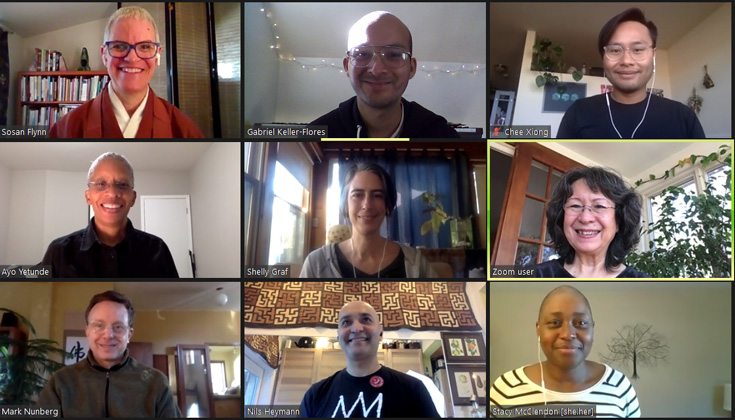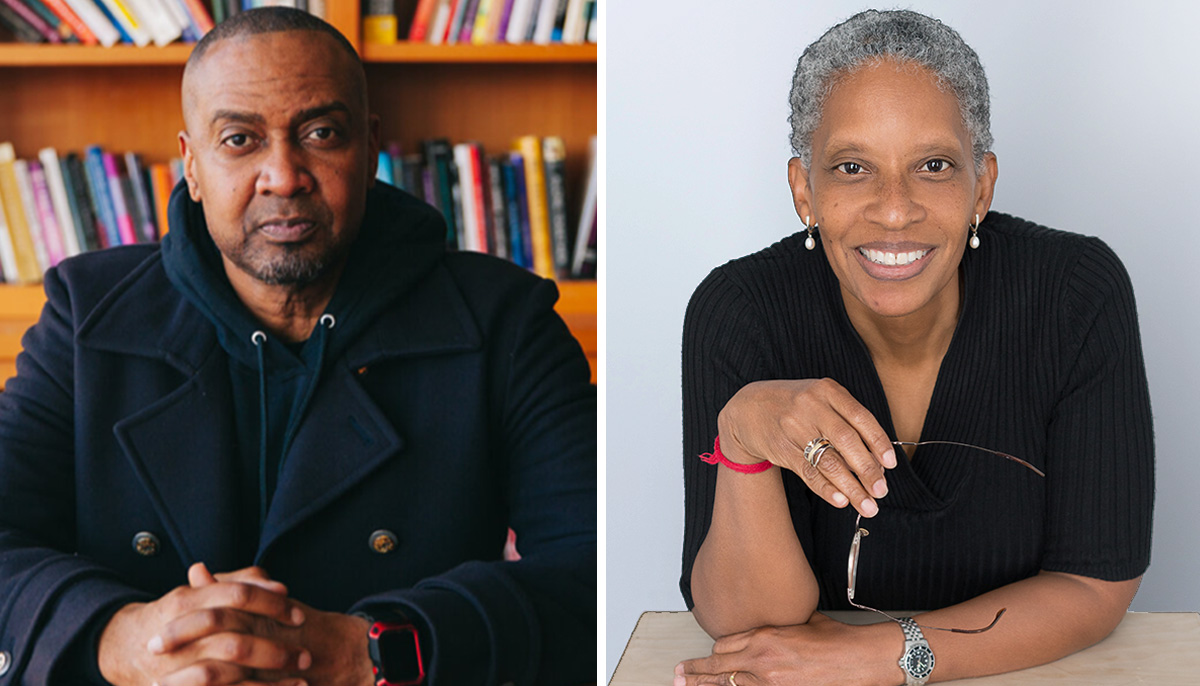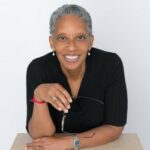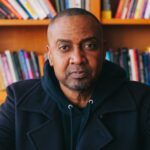In his book, My Grandmother’s Hands, social worker and psychotherapist Resmaa Menakem “examines the damage caused by racism in America from the perspective of body-centered psychology,” offering a body-centered understanding of white supremacy and a step-by-step healing process. The book centers on the practice of “somatic abolitionism,” which he defines as “a living, embodied philosophy that requires endurance, stamina, and discernment,” built day by day through practice and reps.
Here, in conversation with Community Dharma Leader, pastoral counselor, and co-editor of Black and Buddhist, Pamela Ayo Yetunde, he discusses his body of work, and how the practices and insights shared in My Grandmother’s Hands can impact dharma communities and spiritual leaders by leaning into discomfort and choosing to commit to these lifelong practices.
Pamela Ayo Yetunde: You’re a social worker, psychotherapist, and the author of three books I think everyone should read. As a Community Dharma Leader, trained in Spirit Rock Meditation Center’s Lay Leadership program, a Zen student, a pastoral counsellor, and the co-editor of Black and Buddhist, I’m a fan of yours. I come from many perspectives on your work.
Resmaa Menakem: Because of My Grandmother’s Hands, more and more Black Buddhists are asking me to converse with them and talk to them about this idea of embodiment. And so, I’m starting to see more Black people who are Buddhists begin to grapple with this idea of being in a Black body and being Buddhist, and that both must be considered. From the outside looking in, it seems that it’s almost been communicated that you can’t be both. You can’t be Buddhist and be in a Black body.
These are lifelong practices. This is not just something you do to feel better.
Pamela Ayo Yetunde: Right. In addition, it’s also been communicated in some Buddhist communities, that even our own existence is a figment of our imagination — like a dream. They say “Consider all realities as a dream.” But as you know, if you’ve been living a nightmare, you can’t just shift from a nightmare consciousness to a dream consciousness.
Resmaa Menakem: Ain’t that the truth. As a matter of fact, to do so in a structure that is predicated on the white body being the standard of humanness — to try and act like this is all a dream — actually puts you in danger. It literally puts you in more harm’s way.
Pamela Ayo Yetunde: That’s right. I think instinctively, we know that. So that’s something that we have to grapple with, ironically, as we’re trying to come to peace in our bodies — to also hold to the reality that it is not a peaceful existence that we live in. And people who I admire, like Reverend angel Kyodo williams, Lama Rod Owens, and a list of many others, have been reminding Black-bodied people that we don’t have to sacrifice that in order to practice our spirituality.
You grew up as a Black man in the Upper Midwest. When you look at history, you’re not going to find many role models in your profession who look like you. When did the “brightening” happen for you where you said “I can do this, and I’m going to do it.”
Resmaa Menakem: Actually, the brightening happened before I got here. My mom said that since I was born, I always leaned into people. I was always wanting to be with people and around people.
As a Black mother, that probably filled her with joy and dread. But I believe that was the manifestation from creation — that kind of “purpose spark” — that was already in me. The idea of being a therapist, or a communal activist actually comes from that seed of leaning into people. I think that was naturally in me, and I had people around me that helped nurture that. By the time it came to be something that I could do as a profession, it was very much an alignment with who I came here to be.
I didn’t have a mooring that was African-centered until my mid-twenties. In Milwaukee, I had a leaning towards art and music. I grew up living in a primarily Puerto Rican and Black neighborhood. By the time I got to sixth grade and was getting ready to go to junior high, there was no schools in my area that had music and arts as a specialty, so I was bussed to an all-white junior high. It was the first time I had been around that many white folks.
Then I went to a high school of the arts that was mostly all-white as well, and ended up going to a college that was mostly all-white. Stuff started coming together for me in college, and then it’s a progression. When you first start, it’s like “Everybody’s got to be African, and if you ain’t African enough, or you ain’t the right African…” That’s just part of the maturation.
I eventually got to a point to where I didn’t want my son to know me with an English name. So, about 30 years ago I ended up accepting a kemetic name from my elders here.
Pamela Ayo Yetunde: In so many ways when I was reading My Grandmother’s Hands, I kept thinking, “Are we siblings from different mothers?” Because we both changed our names. Now I learn that we were both bussed to white schools around the same year. And I think about my grandmother and the things that I learned from her. There are certain things that are just shared.
Resmaa Menakem: Right. It’s a universal experience. When it comes to Black bodies, especially in this country, there is some universality in terms of our experience. Not in total, but there is some.

Pamela Ayo Yetunde: I lived in the Twin Cities for three years and just left recently. I’m still part of two Dharma communities there, Clouds in Water Zen Center in St. Paul, and Common Ground Meditation Center in Minneapolis.
Recently the two communities formed one entity for a seven-month study on My Grandmother’s Hands. I asked some of the planners why they wanted to do this seven-month long study, and I would like to share with you something said by a Hmong planning committee member. This is what he wrote:
“When brother George Floyd was murdered, and I saw my fellow Hmong, one of the police officers who stood over his body, I felt great sadness and responsibility.
I didn’t know how to metabolize all the emotions that were coming up. I tried to rationalize it to escape from it. I tried many things and then I recalled picking up the book My Grandmother’s Hands when it first came out. That’s when I started reading it. All the feelings that were coming up, the narrative of ‘How could you stand by like that? Don’t you remember where we came from?’ and ‘What did I do wrong to allow for this to happen?’ I read the book with these eyes. And then the body came into place. I started practicing the somatic exercise that was presented. I read the book from a place of hurting and knew that I was not the only one with these feelings.
I felt a deep responsibility to share the book since Resmaa’s work has transformative practices that benefit anyone who was willing to do them. I also consider the practices as another way to enter the Dharma, folding them in with our sitting practice. Any path that leads us toward liberation should be shared and at least investigated.”
So Resmaa, as you reflect on these words, what comes up for you?
Resmaa Menakem: I think where those words landed for me was actually in my stomach. It was a dropping, almost like a free-fall in my stomach — a sense of constriction. Since brother George Floyd, Brother Ahmaud Arbery, sister Brianna Taylor, there’s been this sense of people outside of the Black community saying “How did we get here? What do I do?”
Race has a charge to it. It has a “cooking” component to it that if you start to begin to say, “Well, it’s just about us just being centered. It’s just about settling. It’s just about bringing the breath of God.” If that’s all you’re doing with it, that’s not what I’m talking about.
If you are reading my book, and you’re going through the practices, getting reps in with the practices, and you keep race centered, you will find that things “cook” differently. These are lifelong practices. This is not just something you do to feel better.
Pamela Ayo Yetunde: When you talk about that “leaning in,” that you always had growing up, I’m thinking about what that feels like. In that leaning in, there seems to be a straightening of your own spine.
Resmaa Menakem: Oh, yeah. When you’re leaning into something, one of the things that happens is that you get closer to your own developmental edges. Many times, those developmental edges are not fully formed. The things that are more comfortable are more fully formed than the things that you’re trying to lean into.
Most of the battle and most of the practice revolves around exploring how you can begin to lean into the discomfort, into that suffering’s edges, so you can become more fully realized. So you can find what that spark is. So that can be nurtured more fully. There’s an off balance to that leaning in, and it’s designed to have you continue to practice, to condition, and to temper yourself so you can actually withstand the charge of what it is you’re supposed to be doing here.
When people start to lean into something and it becomes uncomfortable, the natural tendency is to stop. They try and stop the stirring and quaking that happens from leaning into something that is uncomfortable. People have found my work around that to be helpful, but there are people who find it to be helpful for the essence of what it is, and then there are people that find it to be helpful because they’ve pushed it through the same things that they already know.
I’m not saying you should be soothing these feelings down. I’m saying you have to experience it.
Those people want to couch what I’m doing as “Oh, that’s Buddhism. Oh that’s Zen practice. Oh that’s, this, that, and the other thing.” And I have to tell people that my focus is particularly on the body and race, not your self-actualization — that’s not the goal.
What I’ve found happens is sometimes, once the stirring and discomfort starts to happen, people want to “yoga” the hell out of it. Once that stirring starts to happen, they want to Buddhist the hell out. They want to Christian the hell out of it.
People may think that’s what I’m saying, but that’s not what I’m saying. The things that I talk about don’t have anything to do with nationality or ethnicity. This is all about the body and the hierarchy that purports that the white body is human, and the antithesis of that is the Black and Indigenous body, which are rendered non-human or invisible. I’m not saying you should be soothing those feelings down. I’m saying you have to experience it. In the quaking, the rocking, the stirring back and forth, there is room. But you won’t be able to notice the room if you don’t practice discernment. When it’s rocking and quaking, you will do things to try and stop it because it’s so unnerving and overwhelming in an embodied sense.
I’m always telling people, be careful about trying to soothe down or settle down first. Deal with the quaking and the cooking, and see what emerges out of getting the reps in with that as opposed to trying to stop it and feel better.
Pamela Ayo Yetunde: In My Grandmother’s Hands, you kind of give them a forewarning that the material they are about to enter into will be so disturbing that they will want to stop. But you can pause, check in, do your exercise, and then please return.
Resmaa Menakem: Yes, please return. What I find is that people ask me questions because they notice something there, but then they want to ask a a disembodied strategy question. What I’ve been saying to people is that their question really is an emergent question. It is not a strategy question, the question that they want to ask me is an emergent question. The answer to that question emerges out of grinding up against another body and doing the practices with each other. If you do a practice, something will emerge. You’re asking me a question that I don’t know the answer to because I am not you. It has to emerge from you, and then your construction of developing and living embodied anti-racist culture and practice with other bodies.
That answer will be compounded and expanded as you do those practices.
Pamela Ayo Yetunde: Several years ago, I started a Buddhist community, which we call a sangha, in the Atlanta area. The community was meant to be service-oriented, and we chose to serve a battered women’s shelter near where we had our meetings.
Two women agreed that they would offer mindfulness meditation to the women in the shelter, and they happened to be white women. My job was to instruct them on how to give mindfulness meditation, which I did, and they said “Okay, we’re ready to do this.”
After three weeks, both of them dropped out of the project and out of the sangha altogether. When I asked them why they did that, one of them said “I didn’t feel comfortable with my race and my class. I felt uncomfortable in the presence of these Black women in the shelter.” The other one said, “You know, I began to feel like I was a fraud because I don’t meditate regularly.” That was never a prerequisite. It got messy. Resmaa, would you analyze this from your perspective?
Resmaa Menakem: I was the clinical director for a domestic violence treatment organization. Part of what happens is that you have a lot of well-meaning people that come to volunteer for these groups. There’s a lot of people who want to help, but what they don’t realize is that the depth of that help is not very deep. Many times the work — the pieces that you’re trying to avail to somebody else — you have not worked yourself. You haven’t done your own work.
This is what I talk about in my books with the difference between “invited reps” and “life reps.” Invited reps are these reps that you invite in your life in smaller chunks, so you can practice and develop, not necessarily immunity, but antibodies to learn nuance.
If I’m a piano player, and my piano teacher comes up to me and says “Resmaa, you play beautifully. I have no doubt you will be a very successful musician with your right hand,” but I don’t develop that left hand, people will think that I’m really good, but the left-hand piece will let me down. So I’m going to have to figure out how you make my left hand stronger. And that means I’m going to have to be uncomfortable.
That means you’re going to have to get some reps practicing with that hand. You don’t have to worry about the right hand because you know all of the nuances of that hand. Your body knows all of the things that it needs to do in order to play beautiful music with the right hand. The left one is where all your growth is going to be.
So when you trained those women to teach mindfulness meditation, what you were doing was giving them some invited reps — some pieces to get some reps in with and understand. Then when they got into the room for those three weeks, they had a life rep.
Life reps are usually overwhelming. They push you up against your developmental and suffering’s edge. They push you up against them very fast — too fast — and they ask you to transform.
This is why the invited reps are so important. What you found is that your training with them was inadequate. They got some reps, but they needed additional reps. When it got to that harsh life rep, they didn’t have enough of container to be able to hold the charge of race. That happens all the time. People don’t even know they’re wading into the deep end of race until they’re sitting there.
Pamela Ayo Yetunde: Do you find it peculiar that I, an African-American woman, was their trainer, and then when they got into the situation, they felt inadequate?
Resmaa Menakem: They were inadequate before that. That’s the piece. That’s what I mean by suffering’s edge.
It is not your job to excavate 400 years of advantage for white people.
You could have been training them for a year to go in and do that, and you still might’ve gotten the same outcome. You could’ve said something like “Okay, you’re going to go in here and it’s going to be primarily Black, Brown and Indigenous women. Your own pieces around race, class, and advantage are going to come front and center. Don’t give up. There’s something for you to learn — not about helping or curing these women, but about how you have been advantaged simply for being born in a white body. How do you begin to contend with that?”
When that energy shows up in the room, you can, over time, learn how to use it for for freedom, as opposed to stopping or quitting — not pausing. There’s a difference between pausing and quitting. A lot of the time white folks have built in dodges to the structure.
What do I mean by that? That white comfort trumps Black healing. White comfort trumps Black liberation. In this situation, their comfort trumped the practices that might have given those Black women some solace and reprieve.
People have to stay with the charge of race, as opposed to trying to move around it and bring other things to make it more comfortable. White folks do this all the time. They want to plug this stuff into something else that they’re comfortable with. In the process of doing that, they actually dampen their humanity.
Pamela Ayo Yetunde: And their growth.
Resmaa Menakem: And their growth. All of it.
Pamela Ayo Yetunde: Where I think really failed in that situation is that I didn’t give them the confidence that I would be with them to figure it out.
Resmaa Menakem: No. I’m going to to stop you because I care for you. It’s alright. We learn what we need to learn at the time that we needed to learn it. You did not fail. One of the things that Nelson Mandela said is that we never lose. We either win or we learn.
What I want to tell you is this: It is not your job to excavate 400 years of advantage for white people.
Pamela Ayo Yetunde: I agree, and I know that.
Resmaa Menakem: Don’t ever pick that up. You did what you thought you needed to do in order to give a service to Black, Brown and Indigenous people. You learned something about what needs to happen when you’re dealing with white bodies. In My Grandmother’s Hands, you’ll notice I don’t do this work with Black and white bodies in the room together. Why? Because I know white bodies. Black bodies, and specifically bodies of culture, have to be about the work of reclaiming and shutting off the wounds that we’ve ingested from a wounded people.
The Black body is where America has learned to do its dirt.
Our work is really about turning a reclamation into culture, and tying that culture back into creation. White bodies’ works is about rehumanizing — turning that rehumanizing into culture, and then tying that back into creation.

By Resmaa Menakem, MSW, LICSW, SEP
Central Recovery Press
September 2017; 306 pages
When I’m working with white bodies, I have to deal with the frozenness in white bodies first. White bodies have a frozenness to them, a constriction to them, and our whole society got organized around that constriction as standard.
When it comes to white bodies, many times we think, “Oh, we all have the same things to learn. We should just get into a room and hold hands and sing ‘Kumbaya,’ breathe together, and do stretches.” Then we wonder why it’s brittle — why the relationships are brittle.
White bodies have to actually create a container with each other so the cooking that needs to occur around race can begin to happen. When you just present something to them, there’s no container to hold it. Over time they will learn alignment. They will learn discernment. They will learn the things that they need to learn in a white body with other white bodies. That way, they don’t blow that energy through my body or through your body. That’s what they do. The Black body is where America has learned to do its dirt.
Pamela Ayo Yetunde: This dynamic of blowing energy — I know it comes also from non-white bodies as well. We are all blowing something until we grow up.
In your other book, Rock the Boat, you talk about psychotherapy as spiritual and alchemical. You also talk about how some religious leaders are in awe of the alchemical process of psychotherapy. What advice to do you as a psychotherapist have for us spiritual leaders to help people lean in, straighten their spine, and be the leader they are called to be?
Resmaa Menakem: I’m currently writing my next book, Our Grandchildren’s Souls, and one of the things that I’ve been talking about pretty clearly in it is the grooming process of guruship. People can groom you into a position of being a guru like “Oh my God, Resmaa, you’ve changed my life,” and all that, and before you know it, you’ve been groomed into guruship. I’ve been talking with a lot of leaders about how you must resist that.
If you’re a leader in a faith community, you should be pausing all the time.
You have to say “I am no different from you.” Yes, I am doing some things, but I am not your guru. I am just a path. I am on the same path as you, side-by-side.
I think a lot of faith leaders end up getting seduced into guruship as opposed to being a partner on the path and being human.
One of the things one of my mentors used to always say is that we are energy having a human experience. The key is to slowly, and with respect, remove the constrictions that thwart that energy from its full expression. When you’ve been conditioned and groomed into guruship, you don’t even realize that it’s actually a constriction.
When you’re embodied, you can pick up on a constriction. That constriction may show up in your right ear. It may show up there when you violate your integrity, but because you don’t have an embodied language for connecting that violation to what’s showing up in your ear, you override it and just keep going.
The work that I’m trying to do with somatic abolitionism is really encouraging people to pause. Pause. If you’re a leader in a faith community, you should be pausing all the time.
Pamela Ayo Yetunde: Yes. For our wellbeing, and the wellbeing of all we serve. Thank you so much.
See more: Read an excerpt from Black and Buddhist by Pamela Ayo Yetunde: “Bringing Right and Wise Intention to POC Sanghas“


